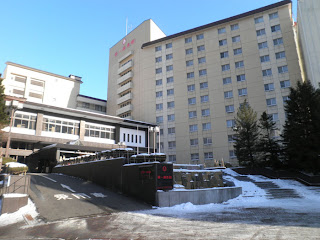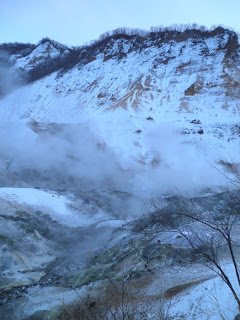From the train station, the town of Noboribetsu Onsen is about 15 minutes' drive up a winding mountain road. There is a huge Demon statue (Oni, the guardian/protector of Noboribetsu) to welcome you into the town. Jigokudani, popularly known as Hell Valley, is just above this town. It is a small town with only one main road with shops on both sides and several hotels. We stayed at the Dai-ichi Takimotokan Hotel, which is a large hotel with hot spring baths within the hotel premises. Some other smaller hotels do not have their own baths and their guests come to use the baths in our hotel.
Wondering around town, we found a small restaurant that serves ramen. It was quite an experience as we sat at the counter and watched the chef prepare bowl after bowl of ramen. We had to wait quite a while for the food to be ready, as the restaurant was packed with people, mostly tourists.
We ordered the edamame beans (毛豆), the shrimp gyoza (煎蝦餃), 3 different variations of ramen (viz 特製叉燒拉麵, 元祖男爵拉麵 and 醬油味拉麵) and braised bear meat (日本醬煮熊肉). The food is quite delicious and served piping hot. Tasting bear meat for the first time, I found it to be not as tough as I had imagined it to be, and the texture was quite like other red meats.
Along the main road you can see big and small statuettes of Oni, the protector of Noboribetsu, with his kanabo (iron club). There is also a shrine dedicated to Enma, the Hell King who guards over the Hell Valley.
At the other end of the main road and a short walk away is Jigokudani, the Hell Valley. It is a spectacular barren valley with steam hissing and spewing out from natural vents in the ground all around. Owing to the volcanic activity underground, the air is filled with the strong smell of sulphur, which takes a while to get used to. There is also a wooden walkway leading down into the valley to a steam water geyser, which erupts once every few hours.
It was a long walk and rather slippery, but it is all worth the effort. It was truly like walking into hell and out again. And the view from within the valley is pretty picturesque.
Visiting the indoor hot spring baths for the very first time was quite another adventure in itself. We had to dress in the provided yukata (Japanese robe) before proceeding to the hot spring baths. Too bad we could not take photos inside the baths, as everyone was totally and completely naked. However, the interesting thing about the Dai-ichi Takimotokan baths is that there are 7 different pools, each featuring water from a specific type of hot spring:-
1. The Cure Spa (salt spring water, 食鹽泉) known to help ease neuralgia, lower back pain and poor circulation. Good for elderly people, the water has a gentle quality and will make your skin smooth.
2. The Healing Spa (sulphur spring water, 硫黃泉) known to help ease chronic bronchitis, hardening of the arteries and chronic dermatitis. It also eases high blood pressure, heal wounds and paralysis.
3. The Heat Spa (salt spring water, 食鹽泉) contain sodium, calcium and chloride and mineral particles that cover the skin surface filling the pores. It is called the Warmth Spa because it is good for rheumatism and those who are sensitive to cold.
4. The Panacea Spa (melanterite spring water, 綠礬泉) known to improve blood formation and circulation by expanding vessels, easing anemia. The highly acidic water also contains large amounts of minerals such as copper and manganese which helps to ease chronic eczema and is good for skin diseases including athlete's foot.
5. The Demon Spa (mirabilite spring water, 芒硝泉) known to improve blood flow, ease hypertension and helps in recovery from fatigue. It also reputedly heals cuts and skin burns.
6. The Beauty Spa (alkaline spring water, 重曹泉) known to help soften connified layers of skin and emulsify secretions, washing away the sebum and making your skin smooth. It also sanitizes wounds such as cuts and burns, prevents inflammation and allergies and eases skin conditions such as nettle rash and atopic dermatitis.
7. The Beautiful Skin Spa (sulphur spring water, 硫黃泉). The smelly hydrogen sulphide in the water helps to expand blood vessels, improve circulation and control the skin. It is thought to ease hardening of arteries, high blood pressure, chronic skin diseases, chronic gynaecological diseases and cuts.
After relaxing in the hot spring baths, it is time for a sumptuous buffet dinner (which is included in the price you pay for your rooms). In the great banquet hall, there are numerous stalls serving dishes from cold snow crabs to sushi/sashimi to soba, ramen, to BBQ favourites and roasts. Then there are the various desserts, including huge fresh lychees, jellies and ice cream. (Just one word of advice, if you are not used to hot springs, do not eat too much for dinner, otherwise it could give you indigestion).
After dinner, it is time to return to your room and lay out your tatami mat, ready for bed. Nothing much else to do at night since the shops close around 9 pm.
One of the attractions you should not miss is the Noboribetsu Bear Park on Bear Mountain. A short walk up the hill from the main road will bring you to the Base Station, where you can take a ropeway gondola to the Summit Station 300 metres above. The 1.2 kilometre ride on the ropeway gives you an amazing view of the hot spring township and the surrounding mountains and valleys.
Up at the Bear Park, you can experience feeding the bears, up close and personal. The brown bears are both lazy and smart at the same time. While lazing around in their enclosure, they will wave and dance to attract the attention of humans to throw bear snacks at them. Really interesting and fun activity.
There is also a Squirrel Village, a Brown Bear Museum, a Bear Mountain Restaurant and souvenir stores at the summit of the mountain. Another interesting feature is the Duck Race where you can make a bet on which duck wins.
All in all, I thoroughly enjoyed my stay at Noboribetsu and wished I had more time to visit the hot spring baths several times instead of just once. Still, it gives me a good reason to visit the place again in the future.






























































































No comments:
Post a Comment